Higher classification Hypodermatinae | Scientific name Hypoderma Rank Genus | |
 | ||
Lower classifications | ||
Warble fly
Warble fly is a name given to the genus Hypoderma, large flies which are parasitic on cattle and deer. Other names include "heel flies", "bomb flies", and "gad flies", while their larvae are often called "cattle grubs" or "wolves." Common species of warble fly include Hypoderma bovis and Hypoderma lineatum (cattle) and Hypoderma tarandi (reindeer). Larvae of Hypoderma species also have been reported in horses, sheep, goats, and humans. They have also been found on smaller mammals such as cats, squirrels, rabbits, voles, and dogs.
Contents
- Warble fly
- Warble fly larvae in roe deer larwy gza u sarny
- Infestations
- Humans
- Treatment and prevention
- References

Adult warble flies are large, hairy, and bee-like and brown, orange, or yellow in color. The adults have vestigial mouthparts, so do not feed during their short lifespans, which can be as little as five days.
They are found on all continents of the Northern Hemisphere, principally between 25 and 60° latitude.
Warble fly larvae in roe deer larwy gza u sarny
Infestations

The fly lays eggs on the forelegs of large animals. The eggs hatch within a week and penetrate the skin, where they migrate throughout the connective tissues (H. bovis) or to the esophagus (H. lineatum). After a few months, the larvae travel back to the skin surface and cause swellings called "warbles". They remain under the skin, and when destroyed by pressure, the larvae can cause large purulent swellings or anaphylaxis. Upon emergence, the fly leaves holes in the skin. Large numbers of such punctures can render cattle hides valueless.
The migrating larvae can cause damage to meat, as the tunnels they make in the muscle fill with a substance known as "butcher's jelly". Infestations also hinder weight gain and growth in the animals. Milk yields may also decline. Most infections in adult cows are minor due to immunity developed over time.
Humans
In humans, the disease intracerebral myiasis is a rare infestation of the brain by the larva of H. bovis. It penetrates the brain by an unknown mode and causes symptoms such as convulsions and intracerebral hematoma. Only three cases appear in medical literature. Myiasis of the human eye can be caused by H. tarandi, a parasite of caribou. It is known to cause uveitis, glaucoma, and retinal detachment. H. lineatum and H. sinense may also infest humans.
Treatment and prevention
Warble fly has been eradicated in many countries, beginning from Denmark and Western Germany, in the 1960s. It was eradicated in the United Kingdom in 1990. It is a notifiable disease. It may have been eradicated from Belgium.
From the 1980s, the preventive treatment is easier, by subcutaneous use of ivermectin, but the warble fly remains present in North Africa.
